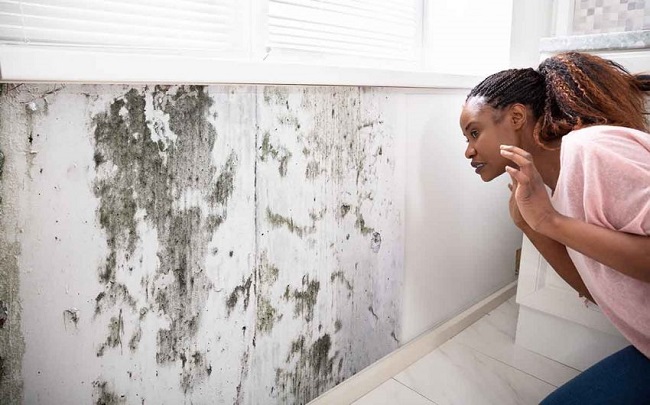These spores are ubiquitous and can be found in the air almost anywhere, including your own home. “all interior surroundings have some mould spores in them,” reports Medical News Today, but “most people are unaffected by this.”
How To Get Rid of Mold Spores in The Air
In low doses, they pose no threat to human health, but in higher doses, they can irritate the respiratory system and trigger symptoms including sneezing, coughing, and a runny nose.
Extreme reactions are possible for those with mould allergies.

Can Mold Spores Be Eliminated From the Air?
We are continuously surrounded by mould spores. They can float in the air indefinitely since their size (between 2 and 100 microns) makes them undetectable to the naked eye. They can be carried long distances and into structures by even the slightest breeze.
The fact is that “mould spores cannot be eradicated from interior surroundings,” as the succinctly puts it. So, if you suspect that mould spores may be contributing to your health issues, what can you do?
Although it is not possible to keep your house fully free of mould spores, there are steps you can take to greatly cut down on the number of spores floating around.
Read Also:
Methods for Reducing Airborne Mold Spores
Using Air Cleaners
Mold spores are airborne pollutants that can be removed with an air filter or air cleaner.
As the system draws in air, it is filtered multiple times to remove even the tiniest particles.
To eliminate mould spores with air purifiers:
- Choose an air purifier with a capacity commensurate with the square footage of the room(s) you intend to clean.
- Install the purifier where it can pull in stale air and push clean air in your direction.
- Depending on the air purifier’s air changes per hour (ACH) and clean air delivery rate (CADR), air purification might take anywhere from 30 minutes to several hours.
- Don’t turn off the air cleaner until you go out of the room it’s in. Once the initial cleaning is done, you can reduce the power setting to prolong the battery life of your device.
If you’re going to be gone for a while, you can switch off the air purifier, but keep in mind that mould spores may start to circulate again if the purifier isn’t always operating.
Cleaners and purifiers for the air come in a variety of forms, including:
- Machines that filter the air (e.g. HEPA)
- Using Electronic Air Filters (e.g. Ionizers)
- Air Filters That Use Gases Instead of Solids (e.g. Activated Carbon)
- Products that use UVGI (Ultraviolet Germicidal Irradiation) to kill germs
- Phosphoric acid photocatalytic oxidation (PCO) cleaners
- Oxygen-Ozone Makers
The contaminants that are removed by various purifiers vary. For instance, tiny particles in the air can be captured by mechanical and electronic air filters, while gases and odours can be removed by gas-phase air filters and PCO cleaners.
Air purifiers with the following features are recommended for eliminating mould spores:
- Filters that remove particles mechanically
- Electrostatic Precipitators as Air Purifiers
- UVGI Sanitizers
- Oxygen-Ozone Makers
Mold spores can be effectively removed from the air with the use of a HEPA (high-efficiency particulate air) filter-equipped air purifier.
Ensuring Enough Airflow
Whether the mould spores in your home are caused by moisture concerns or apparent mould growth, increasing ventilation in living areas may bring fast relief.
The idea is to reverse the normal direction of air movement, with stale air from inside the building being exhausted outside and clean air being brought in.
- Turn on the air conditioning or crack the windows for some fresh air (even for just 30 minutes a day).
- You can assist the airflow out the window by placing a fan there.
- If you want to improve a room’s ventilation, open the door across from the window.
- Air conditioners or ceiling fans should be used when the windows are closed.
- Make sure the fan setting is on “on” if you have a central air conditioning and heating system in your home. Air filters should be replaced every three months.
- Always run exhaust fans in the bathroom, laundry room, and kitchen.
Over time, this should bring the indoor and outdoor mould spore counts down to a safe level for humans.
Even with proper ventilation, mould spores may still be floating about in the air. Those who are allergic or sensitive to mould can use an air purifier to help reduce their symptoms.
Eliminating Mold by Correcting Its Cause
The greatest strategy to reduce mould spore counts in the environment is to prevent mould growth in the first place.
Indoor mould growth is often caused by these common factors:
- Dripping pipes
- A leaking roof
- Flooding
- Humidity
- Condensation
Moisture management is the first line of defence against mould. Mold spores need only a tiny amount of moisture to begin their growth and spread throughout your home.
Read Also:
Here are some things you can do to keep mould from flourishing and spreading its spores:
- In the event of a water emergency, act quickly (leaks, floods, spills). Within 24 hours, you must eliminate the root cause and completely dry the affected area.
- Dehumidifiers can be used to maintain a relative humidity level in the home between 30 and 50 percent.
- Get the most out of your kitchen and bathroom’s ventilation system by opening windows and using fans.
- Use mold-killing cleaners on shower curtains and tiles on a regular basis.
- Whenever possible, direct moisture-producing appliances’ vents outside.
- The drip pans for your air conditioner should be kept dry and clean.






















